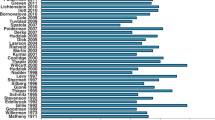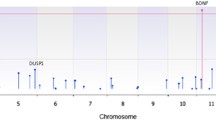Abstract
Attention-deficit/hyperactivity disorder (ADHD) is highly heritable. Confirmed association has been reported for several candidate genes, including DAT1, DRD4, SNAP-25, DRD5, 5HTT, HTR1B, and DBH; however, these confer relatively small risk. Family-based linkage studies have identified a number of chromosomal regions containing potential ADHD predisposing loci, some overlapping in two or more studies, including 5p, 6q, 7p, 11q, 12q, and 17p. New large-scale studies that apply recent technological advances to perform high-density genotyping of the entire genome, in combination with information on the haplotype structure of the human genome, now allow testing of single-nucleotide polymorphism association with disease phenotype without any a priori hypothesis. They may contribute further to our understanding of the genetic factors involved in ADHD. The heterogeneous complex ADHD phenotype, as well as epigenetic factors may be contributing to the challenge of genetic studies. Samples that include limited age ranges may have better success at uncovering genes whose expression is limited to specific developmental stages.
Similar content being viewed by others
References and Recommended Reading
Faraone SV, Biederman J, Chen WJ, et al.: Genetic heterogeneity in attention-deficit hyperactivity disorder (ADHD): gender, psychiatric comorbidity, and maternal ADHD. J Abnorm Psychol 1995, 104:334–345.
Sprich S, Biederman J, Crawford MH, et al.: Adoptive and biological families of children and adolescents with ADHD. J Am Acad Child Adolesc Psychiatry 2000, 39:1432–1437.
Faraone SV, Perlis RH, Doyle AE, et al.: Molecular genetics of attention-deficit/hyperactivity disorder. Biol Psychiatry 2005, 57:1313–1323.
Fisher SE, Francks C, McCracken JT, et al.: A genomewide scan for loci involved in attention-deficit/hyperactivity disorder. Am J Hum Genet 2002, 70:1183–1196.
Smalley S, Kustanovich V, Minassian SL, et al.: Genetic linkage of attention-deficit/hyperactivity disorder on chromosome 16p13, in a region implicated in autism. Am J Hum Genet 2002, 71:959–963.
Ogdie MN, Macphie IL, Minassian SL, et al.: A genomewide scan for attention-deficit/hyperactivity disorder in an extended sample: suggestive linkage on 17p11. Am J Hum Genet 2003, 72:1268–1279.
Ogdie MN, Fisher SE, Yang M, et al.: Attention deficit hyperactivity disorder: fine mapping supports linkage to 5p13, 6q12, 16p13, and 17p11. Am J Hum Genet 2004, 75:661–668.
Bakker SC, van der Meulen EM, Buitelaar JK, et al.: A whole-genome scan in 164 Dutch sib pairs with attention-deficit/hyperactivity disorder: suggestive evidence for linkage on chromosomes 7p and 15q. Am J Hum Genet 2003, 72:1251–1260.
Hebebrand J, Dempfle A, Saar K, et al.: A genome-wide scan for attention-deficit/hyperactivity disorder in 155 German sib-pairs. Mol Psychiatry 2006, 11:196–205.
Arcos-Burgos M, Castellanos FX, Pineda D, et al.: Attention-deficit/hyperactivity disorder in a population isolate: linkage to loci at 4q13.2, 5q33.3, 11q22, and 17p11. Am J Hum Genet 2004, 75:998–1014.
Ogdie MN, Bakker SC, Fisher SE, et al.: Pooled genomewide linkage data on 424 ADHD ASPs suggests genetic heterogeneity and a common risk locus at 5p13. Mol Psychiatry 2006, 11:5–8.
Faraone SV, Khan SA: Candidate gene studies of attention-deficit/hyperactivity disorder. J Clin Psychiatry 2006, 67(Suppl 8):13–20.
Asherson P, Brookes K, Franke B, et al.: Confirmation that a specific haplotype of the dopamine transporter gene is associated with combined-type ADHD. Am J Psychiatry 2007, 164:674–677.
Brookes KJ, Mill J, Guindalini C, et al.: A common haplotype of the dopamine transporter gene associated with attention-deficit/hyperactivity disorder and interacting with maternal use of alcohol during pregnancy. Arch Gen Psychiatry 2006, 63:74–81.
Kereszturi E, Kiraly O, Csapo Z, et al.: Association between the 120-bp duplication of the dopamine D4 receptor gene and attention deficit hyperactivity disorder: genetic and molecular analyses. Am J Med Genet B Neuropsychiatr Genet 2007, 144:231–236.
Xu X, Mill J, Zhou K, et al.: Family-based association study between brain-derived neurotrophic factor gene polymorphisms and attention deficit hyperactivity disorder in UK and Taiwanese samples. Am J Med Genet B Neuropsychiatr Genet 2007, 144:83–86.
Li J, Wang Y, Zhou R, et al.: Association between polymorphisms in serotonin transporter gene and attention deficit hyperactivity disorder in Chinese Han subjects. Am J Med Genet B Neuropsychiatr Genet 2007, 144:14–19.
Li J, Wang Y, Zhou R, et al.: Association between polymorphisms in serotonin 2C receptor gene and attention-deficit/hyperactivity disorder in Han Chinese subjects. Neurosci Lett 2006, 407:107–111.
Deupree JD, Smith Sd, Kratochvil CJ, et al.: Possible involvement of alpha-2A adrenergic receptors in attention deficit hyperactivity disorder: radioligand binding and polymorphism studies. Am J Med Genet B Neuropsychiatr Genet 2006, 141:877–884.
Brookes K, Xu X, Chen W, et al.: The analysis of 51 genes in DSM-IV combined type attention deficit hyperactivity disorder: association signals in DRD4, DAT1 and 16 other genes. Mol Psychiatry 2006, 11:934–953.
Weedon MN, Clark VJ, Qian Y, et al.: A common haplotype of the glucokinase gene alters fasting glucose and birth weight: association in six studies and population-genetics analyses. Am J Hum Genet 2006, 79:991–1001.
Duerr RH, Taylor KD, Brant SR, et al.: A genome-wide association study identifies IL23R as an inflammatory bowel disease gene. Science 2006, 314:1461–1463.
Braun JM, Kahn RS, Froehlich T, et al.: Exposures to environmental toxicants and attention deficit hyperactivity disorder in U.S. children. Environ Health Perspect 2006, 114:1904–1909.
Ben Amor L, Grizenko N, Schwartz G, et al.: Perinatal complications in children with attention-deficit hyperactivity disorder and their unaffected siblings. J Psychiatry Neurosci 2005, 30:120–126.
Neuman RJ, Lobos E, Reich W, et al.: Prenatal smoking exposure and dopaminergic genotypes interact to cause a severe ADHD subtype. Biol Psychiatry 2007, 61:1320–1328.
Knopik VS, Heath AC, Jacob T, et al.: Maternal alcohol use disorder and offspring ADHD: disentangling genetic and environmental effects using a children-of-twins design. Psychol Med 2006, 36:1461–1471.
Thapar A, Langley K, Fowler T, et al.: Catechol omethyltransferase gene variant and birth weight predict early-onset antisocial behavior in children with attention-deficit/hyperactivity disorder. Arch Gen Psychiatry 2005, 62:1275–1278.
Sengupta SM, Grizenko N, Schmitz N, et al.: COMT Val108/158Met gene variant, birth weight, and conduct disorder in children with ADHD. J Am Acad Child Adolesc Psychiatry 2006, 45:1363–1369.
Kahn RS, Khoury J, Nichols WC, Lanphear BP: Role of dopamine transporter genotype and maternal prenatal smoking in childhood hyperactive-impulsive, inattentive, and oppositional behaviors. J Pediatr 2003, 143:104–110.
Laucht M, Skowronek MH, Becker K, et al.: Interacting effects of the dopamine transporter gene and psychosocial adversity on attention-deficit/hyperactivity disorder symptoms among 15-year-olds from a high-risk community sample. Arch Gen Psychiatry 2007, 64:585–590.
Andres RL, Day MC: Perinatal complications associated with maternal tobacco use. Semin Neonatol 2000, 5:231–241.
Larsson JO, Larsson H, Lichtenstein P: Genetic and environmental contributions to stability and change of ADHD symptoms between 8 and 13 years of age: a longitudinal twin study. J Am Acad Child Adolesc Psychiatry 2004, 43:1267–1275
Larsson H, Lichtenstein P, Larsson JO: Genetic contributions to the development of ADHD subtypes from childhood to adolescence. J Am Acad Child Adolesc Psychiatry 2006, 45:973–981.
Hay D, Bennett KS, McStephen M, et al.: Attention deficit-hyperactivity disorder in twins: a developmental genetic analysis. Aust J Psychol 2004, 56:99–107.
Lahey BB, Pelham WE, Loney J, et al.: Instability of the DSM-IV subtypes of ADHD from preschool through elementary school. Arch Gen Psychiatry 2005, 62:896–902.
Croes EA, El Galta R, Houwing-Duistermaat JJ, et al.: Phenotypic subtypes in attention deficit hyperactivity disorder in an isolated population. Eur J Epidemiol 2005, 20:789–794.
Faraone SV, Biederman J, Friedman D: Validity of DSM-IV subtypes of attention-deficit/hyperactivity disorder: a family study perspective. J Am Acad Child Adolesc Psychiatry 2000, 39:300–307.
de Graaf-Peters VB, Hadders-Algra M: Ontogeny of the human central nervous system: what is happening when? Early Hum Dev 2006, 82:257–266.
Li J, Kang C, Wang Y, et al.: Contribution of 5-HT2A receptor gene-1438A>G polymorphism to outcome of attention-deficit/hyperactivity disorder in adolescents. Am J Med Genet B Neuropsychiatr Genet 2006, 141:473–476.
El-Faddagh M, Laucht M, Maras A, et al.: Association of dopamine D4 receptor (DRD4) gene with attention-deficit/hyperactivity disorder (ADHD) in a high-risk community sample: a longitudinal study from birth to 11 years of age. J Neural Transm 2004, 111:883–889.
Barkley RA, Smith KM, Fischer M, Navia B: An examination of the behavioral and neuropsychological correlates of three ADHD candidate gene polymorphisms (DRD4 7+, DBH TaqI A2, and DAT1 40 bp VNTR) in hyperactive and normal children followed to adulthood. Am J Med Genet B Neuropsychiatr Genet 2006, 141:487–498.
McGough J, McCracken J, Swanson J, et al.: Pharmacogenetics of methylphenidate response in preschoolers with ADHD. J Am Acad Child Adolesc Psychiatry 2006, 45:1314–1322.
Mick E, Biederman J, Spencer T, et al.: Absence of association with DAT1 polymorphism and response to methylphenidate in a sample of adults with ADHD. Am J Med Genet B Neuropsychiatr Genet 2006, 141:890–894.
Gainetdinov RR, Wetsel WC, Jones SR, et al.: Role of serotonin in the paradoxical calming effect of psychostimulants on hyperactivity. Science 1999, 283:397–401.
Levy F: What do dopamine transporter and catechol-o-methyltransferase tell us about attention deficit-hyperactivity disorder? Pharmacogenomic implications. Aust N Z J Psychiatry 2007, 41:10–16.
Mattay VS, Goldberg TE, Fera F, et al.: Catechol O-methyltransferase val158-met genotype and individual variation in the brain response to amphetamine. Proc Natl Acad Sci U S A 2003, 100:6186–6191.
Krain AL, Castellanos FX: Brain development and ADHD. Clin Psychol Rev 2006, 26:433–444.
Fan X, Hess EJ: D2-like dopamine receptors mediate the response to amphetamine in a mouse model of ADHD. Neurobiol Dis 2007, 26:201–211.
Wang B, Wang Y, Zhou R, et al.: Possible association of the alpha-2A adrenergic receptor gene (ADR A2A) with symptoms of attention-deficit/hyperactivity disorder. Am J Med Genet B Neuropsychiatr Genet 2006, 141:130–134.
Qian Q, Wang Y, Li J, et al.: Evaluation of potential gene-gene interactions for attention deficit hyperactivity disorder in the Han Chinese population. Am J Med Genet B Neuropsychiatr Genet 2007, 144:200–206.
Author information
Authors and Affiliations
Corresponding author
Rights and permissions
About this article
Cite this article
Elia, J., Devoto, M. ADHD genetics: 2007 update. Curr Psychiatry Rep 9, 434–439 (2007). https://doi.org/10.1007/s11920-007-0057-z
Published:
Issue Date:
DOI: https://doi.org/10.1007/s11920-007-0057-z




